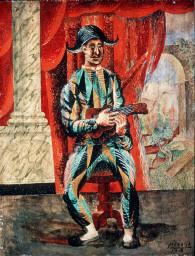Rome is opening its doors on a major new exhibition devoted to the interwar work of Cubist master Pablo Picasso.
Entitled 'Picasso 1917-1937: The Harlequin of Art', the exhibit features over 180 works including oils, drawings and sculpture from museums around the world.
The show focuses on the two decades that art historians have categorized as the most creative and diverse period of the Spaniard's career.
According to the exhibit's curator, Yves-Lain Bois of Princeton University, the sheer variety of works Picasso produced in this era will provide visitors with a comprehensive overview of his lengthy career.
Picasso dipped into as many styles as possible during this 20-year period and the exhibit showcases his ability to juggle the multiplicity of skills needed for this range.
The works on display highlight his traditional cubist oeuvre, which he alternated with an unexpected and lengthy return to neoclassicism, followed by a move into abstract art and, later, surrealism and expressionism.
Organizers have taken the idea of the ''harlequin'', a recurrent figure in Picasso's art, as a springboard for exploring the variety of styles he used at different times.
The earliest such piece is a 1917 portrait of a Russian ballet dancer, Leonide Massine, on loan from Barcelona's Museu Picasso. One of a series of portraits of dancers from the Ballets Russes, which Picasso spent months travelling with on tour, it is a classical painting depicting the male star in a turquoise and cream harlequin costume.
Picasso's 1924 'Harlequin Musician' is a much more familiar cubist creation, on loan from the National Gallery of Art in Washington.
Two Harlequins from 1927, one from the Metropolitan Museum of New York and the other from a private collection, offer abstract and surrealist interpretations of the familiar theme.
Among the other top works on show is a famous painting returning to the Eternal City 80 years after its creation: L'Italienne. Picasso produced the 1917 cubist classic during his first stay in Rome, showing a young Italian girl with the outline of a church in the corner.
This work comes from the same era as his traditional portrait of Leonide Massine, spotlighting the two very different veins he was tapping at the time.
The exhibition opens in the Complesso del Vittoriano this Friday and runs until February 8, 2009.










